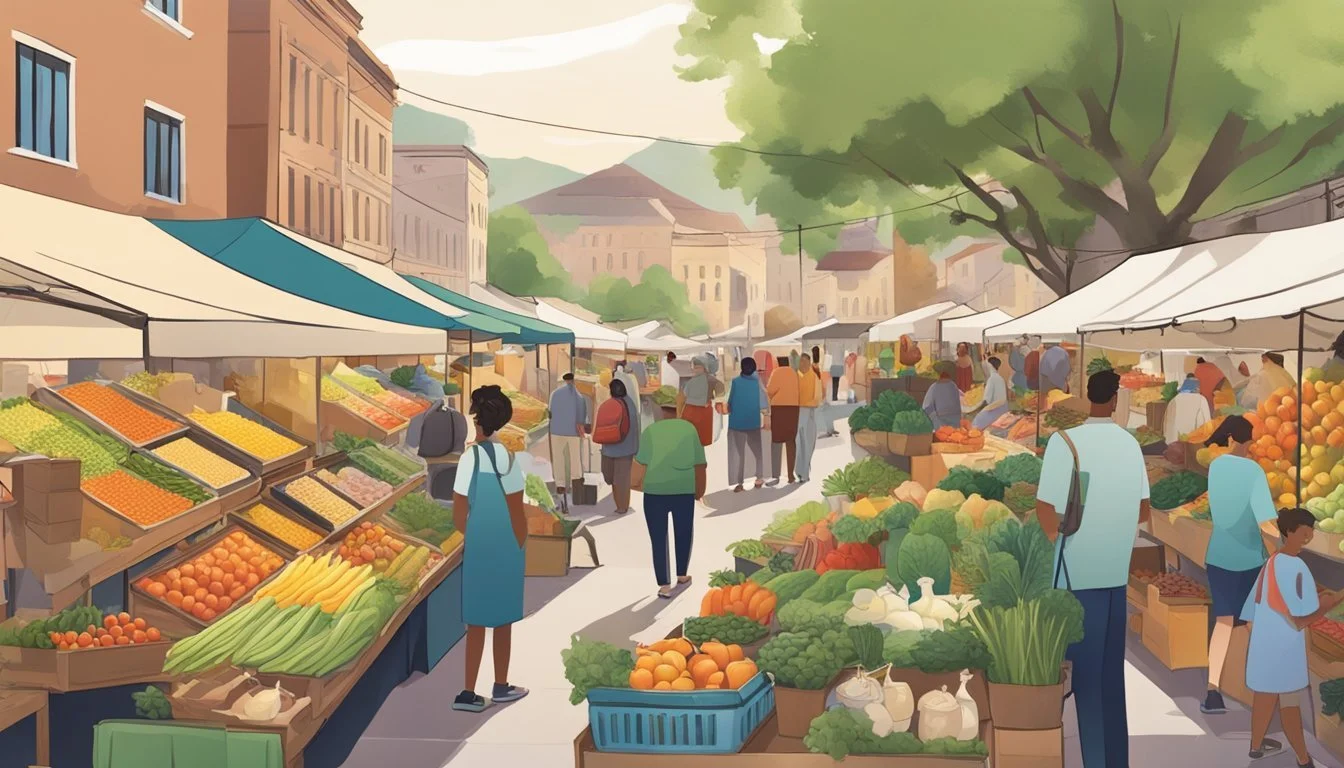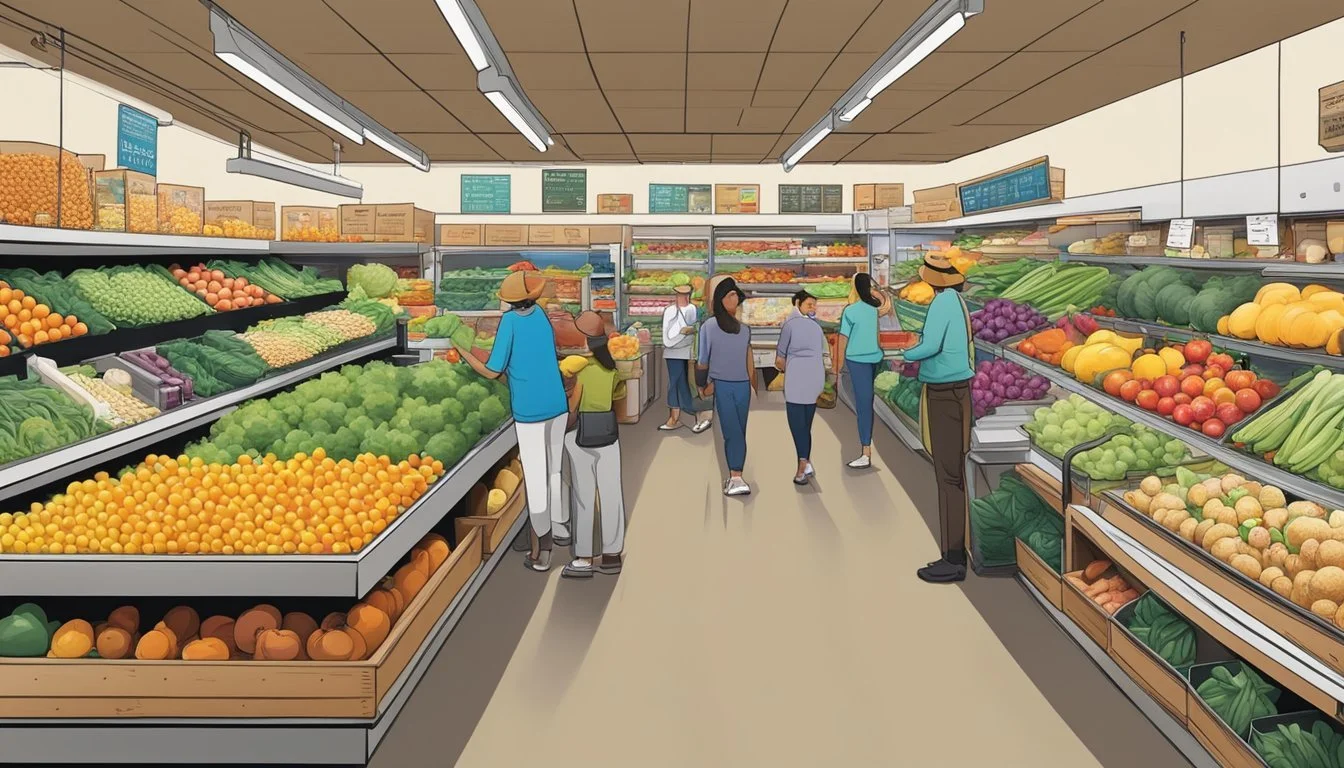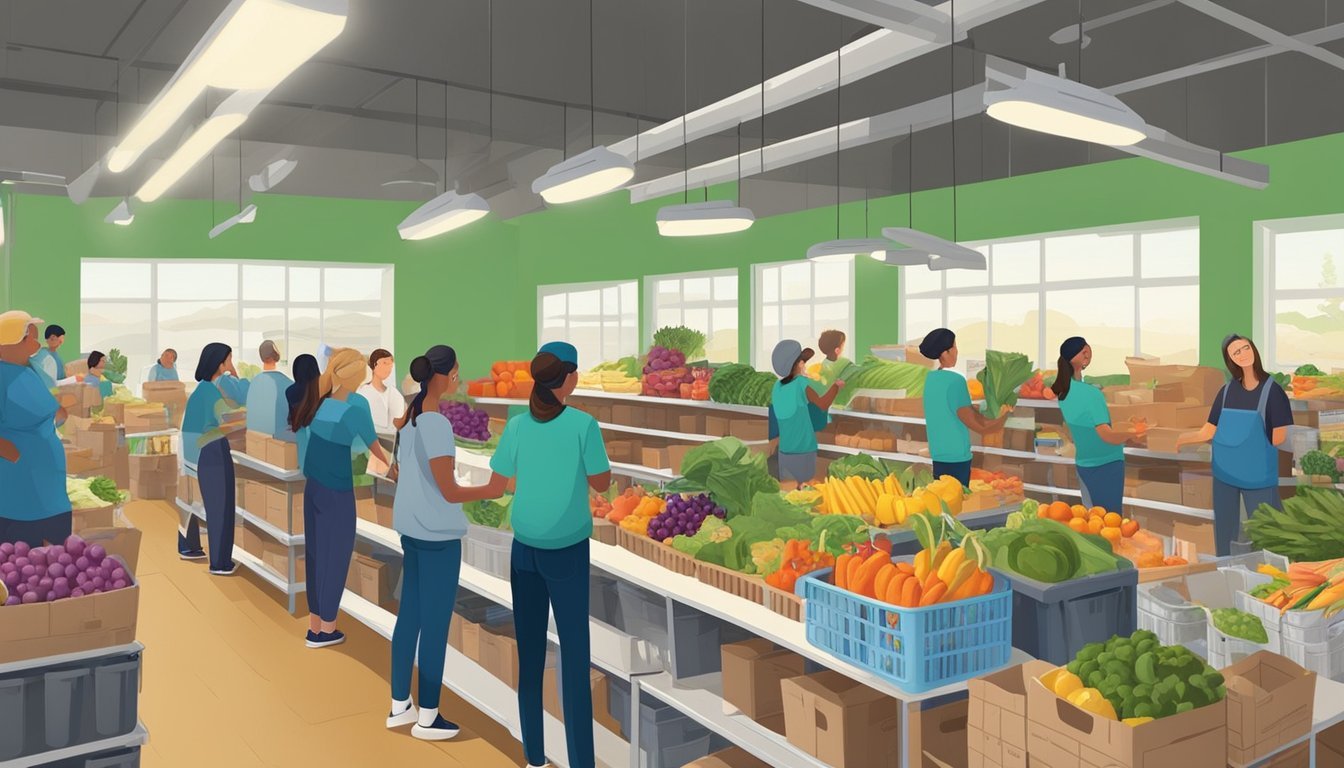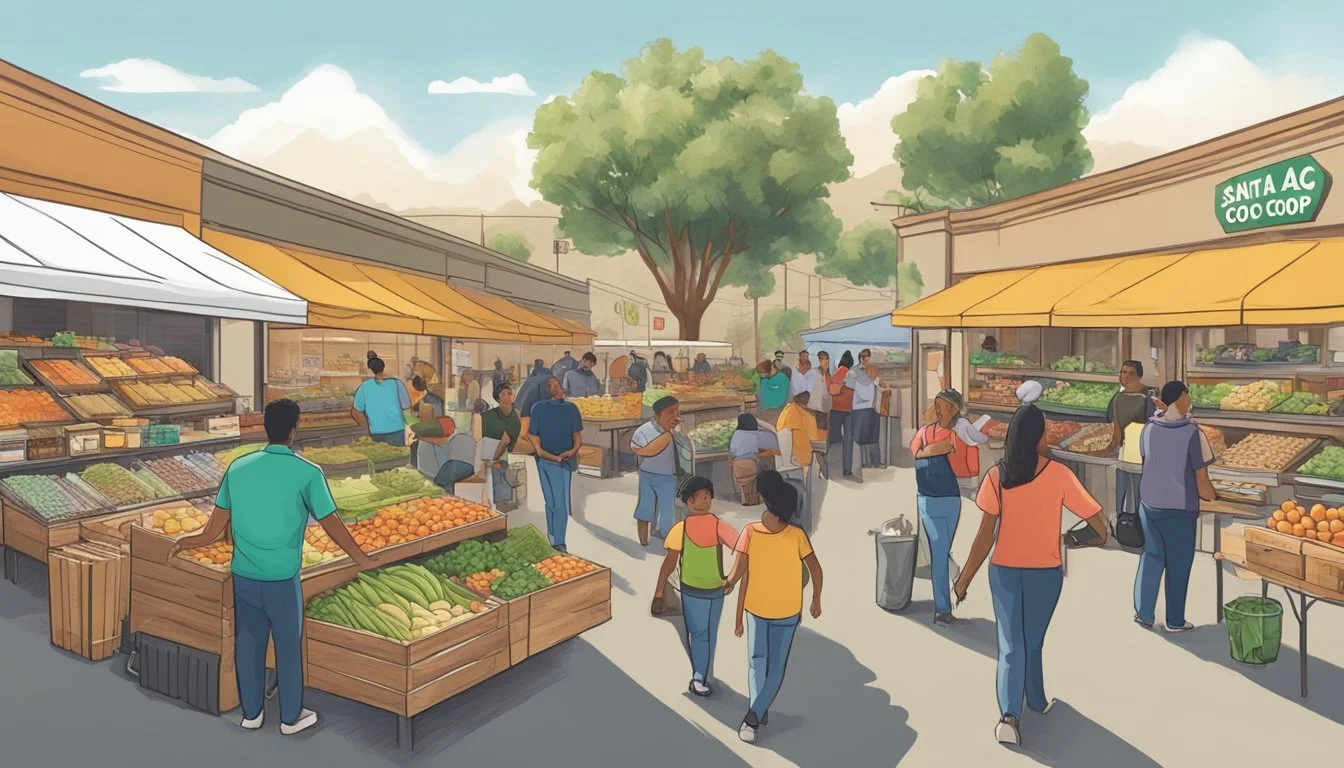Guide to Food Co-Ops in Santa Ana, CA
Exploring Community-Based Options
Santa Ana, California is a community with a growing interest in sustainable food practices and cooperative systems. Amidst the urban landscape, residents and visitors alike have the opportunity to access locally sourced produce and goods through various food co-ops and community-supported agriculture (CSA) programs. These initiatives not only provide access to fresh, organic food options but also foster a connection between the community and local farmers.
The Santa Ana Local Food System, also known as SALSA, epitomizes such efforts by offering a CSA program and operating in collaboration with CRECE Urban Farms. SALSA is a cooperative that is deeply rooted in the principles of democratic management and environmental sustainability. It aims to enrich the community by creating spaces for land stewardship and life-giving work that cater to the health of the body, mind, and spirit. By supporting these local food hubs, residents contribute to a resilient food system that emphasizes collective well-being and food security.
Further assisting those in need, Santa Ana provides free food distributions funded by initiatives like Revive Santa Ana and other city programs, making sure that nutritional aid reaches various segments of the population. Additionally, the city is home to food banks and pantries which offer food distribution on selected days of the week, assuring that residents have continual access to food assistance. These efforts collectively showcase Santa Ana’s commitment to nurturing a supportive food network for its citizens.
What Is a Food Co-Op?
A food co-op, or cooperative, is a grocery store that operates on the principles of collective ownership and management by its members. These members are typically consumers who have a vested interest in the services and products provided by the co-op. They ensure the store aligns with their economic, social, and cultural needs.
Food co-ops often focus on offering educational resources to their members about food sources, health, nutrition, and the benefits of sustainable agriculture. By emphasizing education, co-ops work to inform their community about important food-related issues and empower them with knowledge.
Worker-owned co-ops are distinctive in that they provide ownership and decision-making power to the employees themselves. This structure can foster a strong sense of accountability and pride among workers, as they directly contribute to and benefit from the success of the co-op.
In worker cooperatives, every worker has an equal say in business decisions and an equitable share in the ownership. This democratic approach can result in workplaces that are not only more egalitarian but also deeply invested in the local community.
Food co-ops may offer a variety of products and services, such as:
Locally sourced foods
Organic and natural products
Bulk goods
Specialty dietary options
By shopping at a food co-op, consumers support a business model that prioritizes community welfare and contributes to a more sustainable and inclusive economy.
Benefits of Joining a Food Co-Op
Joining a food co-op in Santa Ana, CA, offers individuals and families a wealth of advantages, from fresher produce to financial savings. These cooperatives are a nexus of nutrition and education, fostering a supportive community dedicated to sustainable agriculture.
Access to Fresh Produce
Food co-ops often provide a wider array of fresh fruits and vegetables compared to conventional grocery stores. Members of Santa Ana co-ops enjoy access to seasonally ripe, locally sourced produce, ensuring high nutritional value and peak flavor. Orange County's Mediterranean climate allows for a diverse selection of locally-grown produce year-round.
Supporting Local Agriculture
By joining a co-op, members invest in local agriculture, which helps to sustain Orange County farmers and reduces the carbon footprint associated with long-distance transportation of goods. Co-ops work closely with local producers to prioritize access to organic and non-GMO vegetables and fruits, which supports the community's overall health and the environment.
Community and Education
Co-ops in Santa Ana are more than just food stores; they're centers for community building and education. They provide opportunities for members to learn about nutrition and sustainable practices. Some co-ops host workshops and events for all ages, and others may offer educational programs for children or partner with local initiatives to provide grants for community agricultural projects.
Financial Savings
Members of food co-ops can enjoy various financial benefits. Co-ops may offer shopping discounts, patronage refunds, or even dividends based on shares owned. Moreover, the shared ownership model of co-ops ensures that money is reinvested locally, often resulting in more competitive prices for high-quality goods. Santa Ana co-ops may also have programs like a free grocery bag day to provide access to healthy food for those in need.
How to Become a Member
Joining a food cooperative (co-op) in Santa Ana entails a straightforward registration process that solidifies one's commitment to community and mutual benefit. Interested individuals should first locate a nearby co-op and inquire about their specific membership requirements, as these can vary from one co-op to another.
Initial Steps:
Visit the preferred co-op in person to express interest in becoming a member. Typically, customer service or membership desks are the first points of contact.
Fill out a membership application form, which collects basic contact information and may ask about reasons for joining or preferred levels of involvement.
Identification:
Present at least one form of identification to verify identity. This could be a driver’s license, passport, or another government-issued ID card.
Financial Commitment:
Payment of a membership fee is usually required. This can be structured as:
A one-time payment or;
Installments contributing towards a member-owner equity.
Payment Type Description One-Time Full Payment The entire membership equity paid upfront. Installment Plan Smaller, recurring payments until equity is reached.
Membership Benefits:
Upon registration, members can enjoy various benefits, such as member-exclusive discounts, pre-order privileges, and a say in co-op governance. A financial contribution might also be refundable under certain conditions, emphasizing the cooperative’s dedication to communal ownership and shared success.
Becoming part of a co-op in Santa Ana is a pathway to not only receive benefits but also to contribute to the sustainability and health of the community. The process is designed to be inclusive, requiring simply a financial commitment, personal identification, and a willingness to support the cooperative model.
Food Co-Op Locations in Santa Ana
In Santa Ana, California, residents have access to various food co-operatives that not only offer fresh and locally-sourced produce but also strengthen community ties. Here are some notable locations where individuals can join or purchase from food co-ops:
SaboryArte: A worker-owned cooperative, SaboryArte serves up authentic Mexican cuisine with an emphasis on ancestral, pre-Hispanic recipes. This restaurant not only provides income for its worker-owners but also celebrates and shares Mexican culture within the Latinx community.
Delhi Center: Acting as a community hub, Delhi Center offers a Revive Santa Ana food distribution program every Monday from 10 a.m. to 11:30 a.m. at 505 E. Central Ave., Santa Ana. Community members are encouraged to bring their own bags to partake in the distribution of food items.
Community Food Pantries: Throughout Santa Ana, several food pantries operate, providing essential groceries to those in need. While the locations and hours of operation may vary, these pantries are pivotal in supplementing residents' food supplies.
Visitors and locals are advised to reach out to these co-ops directly or visit their online platforms for the most current information regarding hours of operation, membership details, and special events. By supporting these food co-ops, individuals not only gain access to quality food but also contribute to the sustainability and empowerment of the Santa Ana community.
Membership Responsibilities
Food cooperatives in Santa Ana, such as the Santa Ana Locally Supported Agriculture (SALSA), often embody the spirit of democratic ownership and management. Members are at the heart of these organizations, taking on a variety of responsibilities. Below is an overview of the typical roles and obligations members may encounter:
Decision-Making: Members may have a say in the co-op's operations, from voting on significant issues to participating in the selection of the manager or board members.
Financial Contribution: A financial investment in the co-op is generally required. This capital contribution supports the cooperative's growth and sustenance.
Volunteer Work: Many cooperatives operate on a worker-owned model, where members contribute labor. This might range from staffing the co-op for certain hours to participating in the management of the cooperative.
Education: Members are encouraged to engage in educational efforts to learn more about sustainable practices and the benefits of locally sourced food.
Community Involvement: The spirit of a co-op extends beyond mere transactions to include fostering a community focused on health, sustainability, and mutual support.
Members assume these responsibilities not just to maintain the cooperative's viability but also to enrich their own and the local community's experience. Co-ops in turn often provide benefits like discounts, a say in the product selection, and a chance to be part of a community of like-minded individuals dedicated to supporting local agriculture and sustainable practices.
Services Offered by Food Co-Ops
Food Co-Ops in Santa Ana, CA, provide a range of community-centered services, focusing on food distribution, education, and supplementary resources intended to support and empower their members.
Food Distribution Programs
Santa Ana's food cooperatives run food distribution programs that ensure members have access to healthy and fresh food options. They offer:
Free grocery bags containing staples and essentials for those in need.
Fresh vegetables and other produce are often sourced from local farms to support sustainability and community health.
Educational Workshops
These co-ops contribute educational value through various workshops. They cater to:
Nutrition education to guide healthier eating habits.
Workshops teaching skills ranging from food preparation to sustainable farming techniques.
Additional Resources for Members
Beyond food distribution and education, the co-ops offer several other resources:
Shuttle services for members needing transportation assistance to the co-op location.
Educational supplies and toiletries are sometimes available for distribution.
Access to a food pantry, equipping members with additional food support.
Special Programs for Subgroups
Santa Ana, CA offers targeted food assistance programs designed to meet the specific needs of veterans, families, and the elderly. These programs provide essential items ranging from nutritious food to basic hygiene products, ensuring support is tailored to enhance the wellbeing of each subgroup.
Programs for Veterans
Veterans in Santa Ana have access to food distribution programs that cater specifically to their needs. These include free food distributions, where veterans can receive essential groceries including baby food and diapers. Some organizations may offer shuttle services for veterans to access these food distributions more easily.
Assistance for Families
Families struggling with food insecurity can find solace in Santa Ana's family-oriented food assistance programs. Essentials such as baby food, diapers, and feminine hygiene products are available, demonstrating the city's commitment to covering basic family needs. Moreover, the programs often include educational components on nutrition, enhancing long-term wellbeing.
Food Pantry Access:
Availability of baby food and diapers.
Distribution of feminine hygiene products.
Support for the Elderly
The elderly population in Santa Ana is not left behind, with programs aimed at ensuring they have adequate nutrition and support. These programs may offer home delivery services or shuttle services, making it easier for the elderly to receive food aid without mobility constraints.
Shuttle Service:
Provides transportation to food distribution centers.
Ensures the elderly can obtain their necessities with dignity and ease.
Produce and Product Selection
Food co-ops in Santa Ana, CA, offer a diverse array of products prioritizing quality, freshness, and local sourcing. These cooperatives often feature seasonal vegetables and fruits, sourced directly from nearby family farms. Shoppers can expect to find a plethora of produce, like leafy greens, root vegetables, and various types of fruit, reflecting the rich agricultural output of the region.
Meat products in food co-ops typically come from local producers who raise their livestock under humane conditions. The co-ops endeavor to provide cuts of meat from animals that have been pasture-raised and fed a natural diet, free from unnecessary antibiotics or hormones.
The product selection goes beyond edibles. Most co-ops also stock a range of household products, which are chosen based on their environmental sustainability and safety. These may include:
Eco-friendly cleaning supplies
Biodegradable personal care items
Reusable food storage solutions
Consumers interested in organic and all-natural products will find that food co-ops are a reliable source for these goods.
Food Co-Ops in Santa Ana typically support practices like:
Consumer education: Ensuring shoppers are well-informed about their food choices.
Member control: Giving members a voice in the selection and sourcing of products.
Community support: Selling locally grown produce to bolster the regional economy.
By frequenting these co-ops, customers help sustain the local ecosystem of growers and producers, while gaining access to some of the freshest food available.
Donation and Volunteer Opportunities
In Santa Ana, California, there are significant opportunities for community members looking to contribute to the local food co-ops and food pantries. These entities often rely on the generosity of donations and the dedication of volunteers to ensure access to food for those in need.
Food Pantries and Co-Ops: Many of these organizations have ongoing requirements for non-perishable food items. Donors can contribute canned goods, dried foods, and other shelf-stable items. It's also an avenue for worker-owned co-ops to connect with the community, allowing them to give back and strengthen their local economy.
Volunteer Needs: These local food assistance programs seek out volunteers who can contribute their time and labor. Tasks may involve sorting food donations, assisting in distribution, or helping with administrative roles.
Opportunities Details Food Sorting and Distribution Volunteers can assist at places like the OC Food Bank, helping sort through donations and preparing them for distribution. Commitment Entities appreciate both occasional and ongoing volunteer commitments, providing flexible options for community members who wish to help. Expertise While no specific expertise is required, worker-owned co-ops might appeal to individuals who have a deeper interest in food security and sustainable practices.
To contribute, individuals should reach out directly to the organization they are interested in. Many require volunteers to complete an application process, undergo training, and meet certain safety standards._food pantry_docnations are typically accepted throughout the week, with some locations such as the Love Community Outreach specifying particular hours for pantry access.
Events and Community Engagement
Santa Ana food co-ops like the Salsa Cooperative Food Hub and the CRECE Cooperative Garden hold a central role in fostering community spirit and knowledge sharing. These cooperatives frequently organize events that emphasize education, nutrition, and community participation.
The Salsa Cooperative Food Hub engages the community through various educational workshops and food distribution events. Participants gain hands-on experience and knowledge about local food systems, sustainable farming practices, and nutritious diets. Cooperacion Santa Ana also offers programs like the Community Supported Agriculture (CSA), where members can learn more about where their food comes from and the importance of supporting local agriculture.
CRECE Cooperative Garden focuses on empowering Santa Ana residents through events that promote food self-determination and environmental sustainability. The garden hosts workshops where individuals can learn about urban farming, organic growing techniques, and the benefits of garden-to-table eating.
Food distributions serve as critical events in Santa Ana, with places like the Delhi Center offering regular access to fresh produce. Participants are encouraged to bring their own bags to these distributions, which not only provide nutritional support but also an opportunity for community interaction.
Event Type Location Focus Educational Workshops Salsa Cooperative Food Hub Sustainable farming, nutrition CSA Program Cooperacion Santa Ana Local agriculture education Urban Farming Workshops CRECE Cooperative Garden Organic farming techniques Food Distribution Delhi Center Access to fresh produce
By engaging in these events, residents of Santa Ana can contribute to and benefit from a resilient and nourishing local food ecosystem.
FAQs About Food Co-Ops
What is a food co-op and how does it work? A food co-op, or cooperative, functions democratically with members having a say in its operations. They typically prioritize local, organic produce, fostering diversity in food sources and supporting regional farmers.
How do you register to become a member of a food co-op? Registration processes vary, but generally, individuals must fill out an application and pay a membership fee to join. Member benefits often include discounts and voting rights.
What kinds of produce can I find at a food co-op? Food co-ops usually offer a wide range of produce, focusing on seasonal and locally sourced items. This can include fruits, vegetables, dairy, meat, and pantry staples.
Are food co-ops open to non-members? While some co-ops are exclusive to members, many allow non-members to shop but may charge non-member prices. It’s best to check with the specific co-op's policy.
Can I find a food co-op in Santa Ana, CA? While direct information about food co-ops specifically in Santa Ana is not provided, they are prevalent in California. Shoppers seeking a co-op experience might find options in nearby communities.
Getting The Most Out of Your Co-Op
When joining a food co-op in Santa Ana, CA, members can truly optimize their experience by being proactive and engaged. The following pointers are tailored to help individuals get the most value and enjoyment from their co-op membership.
Be Informed
Members should always stay informed about the co-op's offerings and policies. Regularly checking the co-op’s bulletin boards, newsletters, and website can ensure they are up to date. It's also beneficial to attend member meetings.
Check for special discounts or member sales
Sign up for newsletters and alerts
Take Advantage of Member Benefits
Besides access to fresh, locally-sourced food, many co-ops offer member-exclusive perks. These might include:
Discounts on classes about nutrition or cooking
Savings on bulk purchases
Special orders for unique or hard-to-find items
Volunteer
Volunteering at the co-op can provide a deeper sense of community and additional savings. Volunteer efforts might include:
Helping with inventory
Participating in community events
Supporting local food drives
Collaborate and Share
Engage with the community by joining cooperative efforts, which can result in shared recipes, cooking tips, and even joint bulk purchasing to save costs.
Suggestion Box
Never hesitate to provide feedback or suggestions that can benefit the co-op and its members. This active participation is vital in ensuring the co-op meets the community's needs.
Involvement and staying informed are essential to getting the most out of a food co-op. By following these steps, members will not only enrich their own experience but also contribute positively to the co-op's mission and the Santa Ana community.














